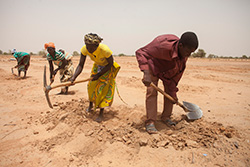Drought
 Drought, which occurs in nearly all regions, has affected more people worldwide in the last 40 years than any other natural hazard. It is a complex natural phenomenon with varying levels of intensity, duration, spatial extent and impacts. Severe drought episodes have drastic socio-economic and environmental impacts, including, for example, massive famines and migration, natural resource degradation, and weak economic performance. Agriculture is the first sector affected when drought hits and also the most affected sector, absorbing up to 80 percent of all direct impacts, with multiple effects on agricultural production, food security and rural livelihoods.
Drought, which occurs in nearly all regions, has affected more people worldwide in the last 40 years than any other natural hazard. It is a complex natural phenomenon with varying levels of intensity, duration, spatial extent and impacts. Severe drought episodes have drastic socio-economic and environmental impacts, including, for example, massive famines and migration, natural resource degradation, and weak economic performance. Agriculture is the first sector affected when drought hits and also the most affected sector, absorbing up to 80 percent of all direct impacts, with multiple effects on agricultural production, food security and rural livelihoods.
Climate change is exacerbating drought in many parts of the world, increasing its frequency, severity and duration.

Drought cannot be stopped and is difficult to forecast. Its impacts can, however, be mitigated through the adoption of a proactive, risk-based management approach aimed at increasing the resilience of communities and societies and their capacity to cope with drought. The approach emphasizes monitoring and managing the stress conditions stemming from drought through policies, strategies and action plans that are implemented before, during and after a drought event. Experience shows that countries that have shifted to this sort of approach are better prepared to deal with drought than those that continue to manage it reactively through the provision of emergency responses as drought exacts its toll.
Supporting countries to shift to a proactive drought management approach is at the heart of FAO’s Strategic Objective of increasing the resilience of livelihoods to threats and crises. The overall goal of FAO’s actions on drought is to develop the capacity of drought-prone countries to increase societal resilience and enhance their drought responses and recovery capabilities to reduce the impacts of future drought events. FAO’s support materializes through the flowing actions:
- Awareness creation to improve understanding among policy-makers and decision-makers of the importance of drought risk management (e.g. through the organization of high-level events, such as the MHNDP, the African Drought Conference)
- The development of guidelines tailored for specific drought-prone regions and of other technical tools to facilitate the adoption of proactive drought management policies at the country level
- Capacity development in drought policy through training at the regional and country levels
- The provision of direct support to countries to implement proactive drought management policies through field projects
- Building partnerships with specialized organizations and research centres as well as with country-level and regional networks of institutions concerned with drought to promote proactive drought policies and enhance country support
- Carrying out studies to characterize drought and its management in different regions

FAO’s programme on proactive drought risk management cuts across the Organization’s technical and cooperation departments and involves strong partnerships with specialized organizations and research centres beyond FAO. Collaborating partners include the World Meteorological Organization (WMO), the Secretariat of the United Nations Convention to Combat Desertification (UNCCD), the Convention on Biodiversity (CBD) and UN-Water, as well as the Robert B. Daugherty Water for Food Institute and the National Drought Mitigation Center at the University of Lincoln-Nebraska, United States of America. The programme also coordinates with several national research centres and regional networks concerned with drought issues.
